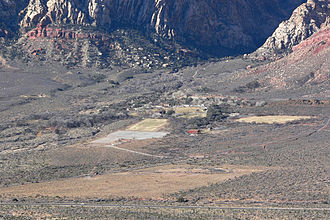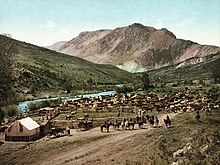Ranch
![]()
Ranch is a redirect to this article. For other meanings, see Ranch (disambiguation).
The term ranching refers to the stationary form of extensive animal husbandry in naturally occurring open landscapes (form of so-called pastoralism). It is particularly widespread in the temperate and subtropical short-grass steppes of North America, South America, South Africa, Australia and New Zealand. The name is derived from the term "ranch", which in English means the seat and dwelling house of a stockman. In Australia and New Zealand it is called "cattle or sheep station", in South America estancia or fazenda and in Southern Africa farm.
On a ranch, mostly cattle production is practiced, in very dry areas also sheep production (for example Karakul sheep in Namibia). Due to the better adaptation to the ecological conditions, wildlife husbandry also occurs today in some cases (for example bison or guanaco). The herds are tended by more or less semi-sedentary pastoralists (cowboys, stockmen, vaqueros, gauchos, etc., depending on the country). In most cases, meat and leather are produced. Additional agriculture is rare.
Ranching is the main form of land use in areas that are too dry for arable farming: such as semi-arid dry savannas and steppes beyond the agronomic dry limits. Due to the lack of rainfall, this form of agriculture is tied to very large areas of land. The minimum size of a US ranch is 500 ha. In the Great Plains and intramontane basins of the Rocky Mountains, ranching reaches over 100,000 ha, and in Patagonia up to 200,000 ha, with the largest areas in the driest regions. To a lesser extent, ranching is common in semihumid to humid grasslands such as the Pampa Humeda in southern and the llanos in northern South America, and in some regions of the prairie states of the United States. Here, however, displacement by the creation of new cropland is increasingly taking place.
.jpg)
Nibepo-Aike Ranch in Southern Patagonia (Argentina)

Ranches are farms in the middle of unsettled, naturally occurring open landscapes.
Differences to mobile systems
In contrast to traditional forms of mobile long-distance grazing, the ranchers' homes are usually located within the grazing area. Other differences include the more complex management of pastures (sometimes supplemental seeding of forage grasses, well digging, human-planned grazing rotations, fencing, and the like). In addition, stationary livestock systems often use only one animal species or breed, while mobile systems are based on two or more species. Seasonally used housing is rarely present in either form.
Another - essential - difference is the market economy orientation of the ranches: subsistence production for one's own needs - as is still often the case with nomadic animal husbandry - only rarely occurs as an additional benefit (example: complex transhumance in central Utah or southern Idaho).

Ranching: Fencing, Grazing Management and Market Economics on the Steppes and Savannahs (Entrance to TA Ranch in Wyoming)
History
Ranching was developed by European settlers in the arid regions of America and Australia, and from there was transferred to other parts of the world (for example South Africa). The roots probably lie in summer-dry Iberia, where in the course of the Reconquista deserted, semi-arid areas were used by large herds of merino sheep and cattle under the supervision of mounted shepherds. This agricultural system found its way into the deserted grasslands of the Americas with the Spanish-Portuguese conquest in the 16th century: the pampas, the Gran Chaco, the sertãos of Brazil, the llanos of Venezuela, the drylands of northern Mexico, Texas' and California. The fencing of vast areas with barbed wire was deliberately promoted in the late 19th century to protect the herds from predators and to manage them better, but also to mark and enforce the ranchers' claims to ownership over indigenous peoples (for example, Prairie Indians in the USA, San in Southwest Africa or Aborigines in Australia). Until the beginning of the 20th century, the orientation towards the world market increased, but decreased thereafter: In South America in favor of supplying the rapidly growing cities in the individual states, and in the industrialized countries primarily through the political protection of national agriculture from foreign competition (agricultural protectionism).

Typical cattle farm near Gobabis, Namibia (2017)

Roundup 1898 on the Cimarron River
Search within the encyclopedia